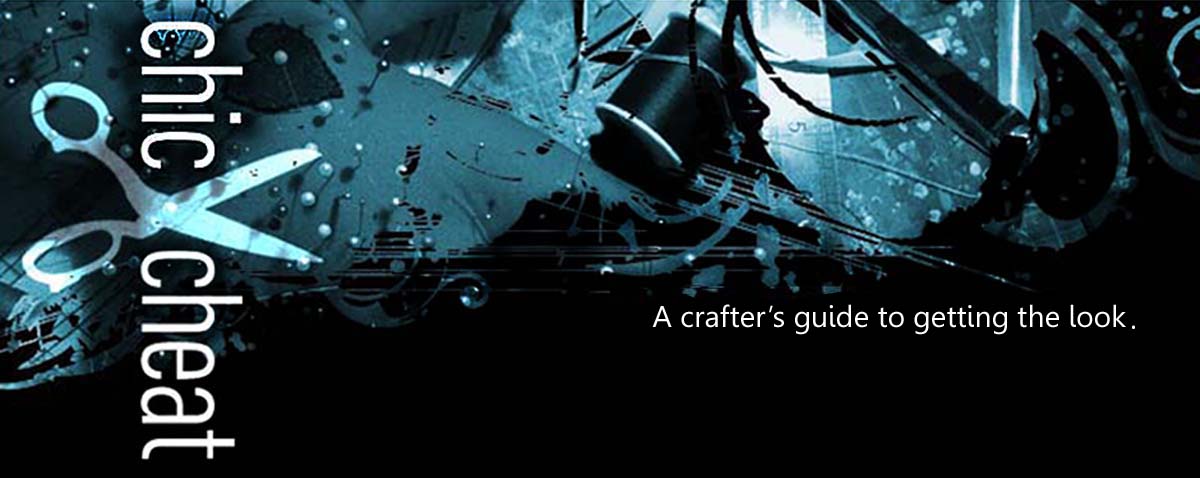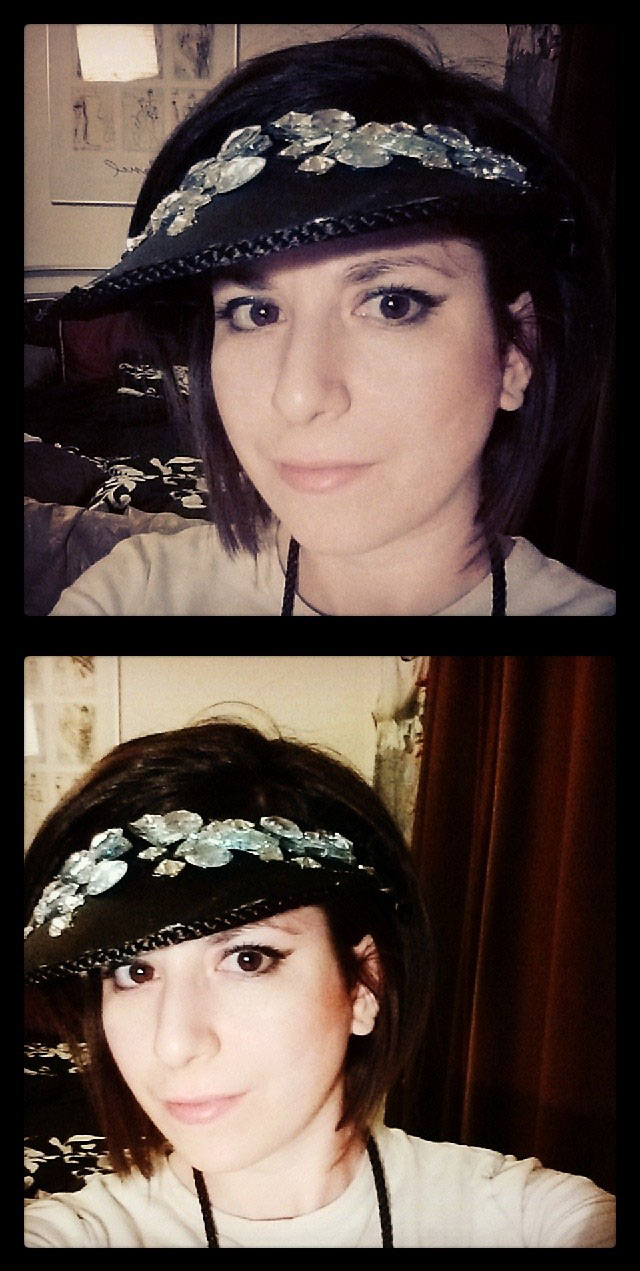Monday 31 March 2014
My DIY Stella McCartney black lipstick intarsia jumper
Monday 24 March 2014
Hand haute - How to DIY a Vivetta White Rachelle Hands Shirt
Get a surreal deal with this Elsa Schiaparelli-style shirt refashion!
Top image: Style.com
You will need...
It also helps to have a fine-tipped pen, pencil or tailor's chalk to trace out the hand design onto your collar.
I will be using a template for the hand design, so you might find it helpful to print the shape out, but a printer is completely optional (and has to be worth the sanity it typically costs you, in my experience!).
Difficulty
Easy
Nothing struck me as particularly challenging for this one but, as always, care and love are needed for best results.
Time
About 2 hours.
Hand it over!
Pin the pattern paper to the collar of your shirt and trace the edges, so that you know what size to make your hand template.
Copy or print out the above hand design and trace it onto your pattern paper to fit the collar outline you have drawn. Make sure the thumb, index and middle fingertips touch the edges of the collar outline - it's even better if you can get the other tips to fit the collar shape but all collars are different!
Cut out your template and trace the hand design onto each side of the collar. You will have to turn your paper over when you change sides, in order to get the design symmetrical.
Cut out the hand design and cut away the edge of the collar along the middle, so that the new edges are raw, with no top stitching.
Paint black 'nails' onto each finger on the top layer and leave them to dry. You should be left with two layers of fabric along the collar - both of which are cut into the hand design. Iron interfacing onto the inside areas (the 'wrong' sides) of the two layers.
Cut away the excess interfacing and top stitch the two layers together about 1mm from the edges, or as close to them as possible.
Tip: It helps to use glue to hold the layers together while you sew them. Make sure your glue's fairly dry and not slimy, like gemstone glue. I used craft mount.
My shirt was short-sleeved, so I added some broderie anglaise trim (2012's finest!) along the cuffs.
Sunday 16 March 2014
Marni, Marni, Marni - How to DIY a Marni Visor
Marni's attention-grabbing accessory is a 'shade' more experimental as a style statement!
You will need...
Just to clarify, you need 180cm of rope.
I got my visor from Hobbycraft and would recommend it. Alternatively, you can cut out a piece of foam 24cm wide, in the shape of the template, below.
Difficulty
Pretty easy
I can't think of anything too challenging or painstaking with this project but I figured I'd err on the side of caution and not declare it a total doddle.Time
2-3 hours, I think.However, it is amazing how little you can keep track of time in the company of Mr. Television so I'm not entirely sure I'd like to give it a more specific timeframe than 'a leisurely evening,' if that makes sense.Re-visory
Remove the strap from the visor and use craft mount to cover both sides of it in satin, ensuring the right side of the fabric is showing.
Use the glue gun to attach rope along the edges.
Punch holes in the corners; you can use a hole punch, scalpel or even scissors. Cut two pieces of rope about 50cm in length, thread them through the holes, tie them in knots and secure them using the glue gun.
Thread the two lengths of rope through the tassels, fold them back on themselves and secure them using the glue gun.
Monday 10 March 2014
D-Eye-Y - How to DIY your own eye-printed clothing
The eyes have it this season!
If the blog and street style avenues are to be believed, Kenzo's eye prints - and anything resembling them, as I'm sure the high street will be quick to point out - are the motif to be seen with right now, so I thought I'd share a nifty little tip for recreating the pattern.
You will need...
NB: My foam was about 1cm thick.
Difficulty
Quite easy
...But not as easy as I thought before I tried it. This isn't a particularly long or complicated project but it's more reliant on skill than I initially thought. As ever, I can guide and advise you so that you don't find it so hard. You can also practise on some scrap fabric to get the feel.
Time
An evening...well, a few hours. Sorry, I got a bit lost in the project so I wasn't counting!
Timings for this project depend largely on the number of eye motifs you're looking to do; if you're only doing one it will take less than an hour but if you're covering your top it will take significantly longer.
Eye-eye!
Cut out the circle and eye shapes into your foam using the above template. I made my circle about 9cm in diameter and the eye about 4cm from the tips of the eyelash.
Now to craft some stamps! Cut the lid of your box into smaller pieces that cover your foam shapes and glue the shapes to them.
Repeat this process until your design is complete.
Loving the stamp action? Check out this tutorial.
Monday 3 March 2014
Haute metal - how to DIY your own metal plated cut out shoes
Cutting it with an on-trend upcycle!
You will need...
The snips I used are called tin snips.
*Relax, the lighter is optional and not recommended for faux leather shoes or near flammable furniture!
** Make sure you use metal araldite glue; only a solvent of that strength is going to work!
Difficulty
Quite hard
This one did prove to be more of a challenge than expected; working with metal is very fiddly and demanding of elbow grease. However, since I had never worked with metal before, I learnt from the mistakes I made and will hopefully be able to guide you so that you don't find it so difficult.
Time
About two afternoons, so 8-ish hours. Again, I was disappointed that I didn't find it easier but I bit off more than I was expecting to chew with the metal. Thankfully, the results are totally worth it.
Cutting it...
After cutting your shapes out, use a lighter to smooth the edges (only if the shoes are leather - faux leather shoes would be ruined). Again, this part is completely optional and only applicable where appropriate, i.e. nowhere near flammable objects.
Finish the edges by gluing trim over them. You can use the scalpel to smooth away the excess glue or cut away extraneous blobs after they're dried.
Cut the above shapes out in metal with the amounts specified. The strips on the left are for covering buckles, so if the buckles of your shoes are already metal, you don't have to worry about them.
The shape in the middle is for the tips of the straps. It needs to be just wide enough to cover them but narrow enough to fit through the buckles. You might want to test it before bending it into shape and gluing it, to make sure that it fits; making a strap tip that's too wide, bending it into shape and then trying to cut it down is much harder, as I would know! The areas for folding back along the edges should be at least 1cm wide, as they're too hard to bend otherwise.
Once you have cut out the metal shapes for the tips of your straps, you may notice some fold lines in the template. I find it helps to draw them in place with a pen that can write on brass; for this, I used an extra fine silver marker.
Hold your piece of metal down and bend it with the tip of your pliers touching the line; I find this method's the easiest and requires the least brute force (something I don't have much of, especially in my hands and forearms!). Don't bend your side bits all the way as you will need to slip your straps underneath them.
Apply glue inside the metal tips and on the surfaces of the straps, and slot them into place.
The trapezium shapes, shown on the right of the template, will be placed over the arch of your foot - shoes follow that arch shape in the place where you're due to glue them - so bend them along the length. This will make them much easier to glue down.
Apply glue to the underside of the metal pieces and onto the surface where you intend to stick them. Again, make sure they're in the same places on both shoes.
Leave your glue to dry. You might have to leave it overnight. Make sure you leave it for as long as the instructions specify.
...and there you have it!
Subscribe to:
Posts (Atom)










































